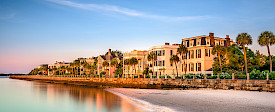When To Go
The best time to visit Charleston is from March through May and from September to November. Flowers and trees are in bloom, the temperatures are mild, and visitors can enjoy a full roster of events from house and garden tours to food and wine festivals. June through August can be quite warm when the temperatures reach the upper 80s. The temperatures become mild from September through December and, best of all the crowds disappear. There are many events planned during this time of year that include a jazz festival, restaurant week, an arts festival and, in December a holiday festival of lights. In January and February the temperatures remain fairly mild and most days are between 50 and 60 degrees, making Charleston a pleasant year-round destination. In January there is a popular oyster festival. Charleston is considered to be one of the most romantic cities in America and is especially is popular in February for Valentine’s Day.


Why Go?
Charleston has a colorful history because it played a key role in both the Revolutionary and Civil Wars. Today, some refer to Charleston as the “Holy City” because of the church spires that punctuate the skyline, but most of the time, visitors use the words charming, elegant, and welcoming to describe this southern gem.
Perfect for American History Buffs
Founded in 1607, by English colonists, and playing a pivotal role in the Revolutionary War, a visit to the replica of the original English settlement on the grounds of the Charles Towne Landing is fascinating.
It is said that the first shots of the Civil War were fired at Fort Sumter. Today the sea fort, only accessible by boat retains most of its original structure as well as a few cannonballs that are embedded in the wall. At Battery Park, visitors will find cannons, historic statues, and spectacular views of the Charleston Harbor.
History comes alive at the Old Exchange and Provost Dungeon as guides in Colonial dress talk about pirates, Presidents, and patriots that were once held here. Visitors will see a section of the 1698 fortification that once protected the walled city of Charleston. This building, completed in 1771, as the New Exchange and Customs house is considered to be South Carolina’s most historic building. This is where history took place – it is where the Constitution was ratified and George Washington entertained.
Charleston Tea Plantation
Located on Wadmalaw Island in the heart of Low Country this is the only tea plantation in North America and, the experience of a lifetime – even for coffee drinkers! Imagine looking at hundreds of thousands of tea bushes that stretch into out into the landscape as far as the eye can see. The trolley ride takes visitors for a close up view of the tea plants. A tour of the tea factory follows the trolley ride. Visitors will walk the entire length of the tea production building to see how tea is processed from start to finish. With the exception of the Charleston Tea Plantation, all other tea plantations are located in Asia, Africa, India, and China. And, yes, there is a gift shop.
Houses and Plantations
Magnificent plantations offer more than a glimpse of Charleston’s fabled past. Magnolia Plantation and Gardens, on the register of Historic Places has a world famous 19th century “Romantic Style” garden deemed as one of America’s most beautiful. The McLeod Plantation is an important 37- acre Gullah/Geechee heritage site that includes a riverside pavilion, a sweeping oak allee and, the McLeod Oak, thought to be 600 years old. This plantation was built on the riches of island cotton and on the backs of the enslaved people that worked there. A visit here helps to understand Charleston’s complex past.
Low Country Love for Foodies
Charleston’s Low Country cuisine is known for its seafood and down home humble cooking. Many of Charleston’s traditional low country dishes date back to the food created by the enslaved people that once worked on the plantations. Today, there are new and hip embellishments on traditional food. Charleston’s signature dishes include shrimp and grits, and she crab soup, a creamy soup made from crabs and roe from female crabs that give this soup its’ pale orange color. Other local favorites include oysters, mustard based BBQ and hash, and fried whiting and red rice.
As for a drink Charleston and Madeira, a tiny island off the coast of Morocco have a long history. In this area, Madeira was the most consumed wine of the colonial era. After the Revolutionary War a strong trade was developed, Charleston wanted Madeira and Madeira wanted rice. Prominent landowners planted Madeira grapes that were destroyed in the 1850s due to a mildew outbreak and Madeira went out of favor because it was not easy to get. Today, a few vineyards are bringing back Madeira wine production.


